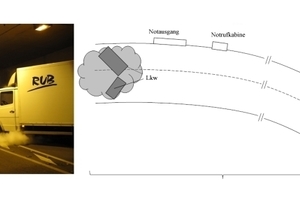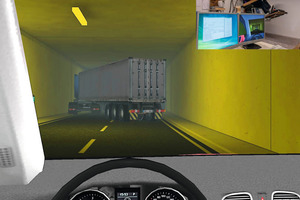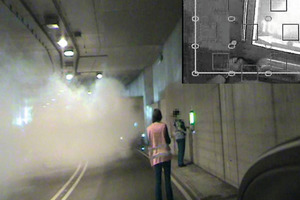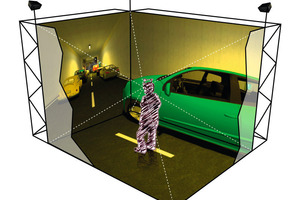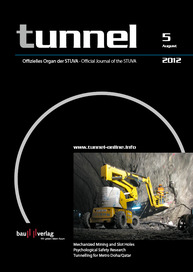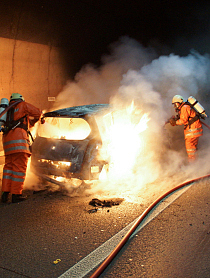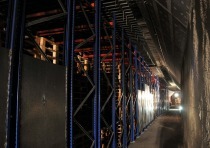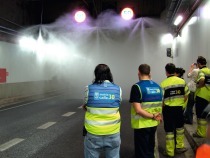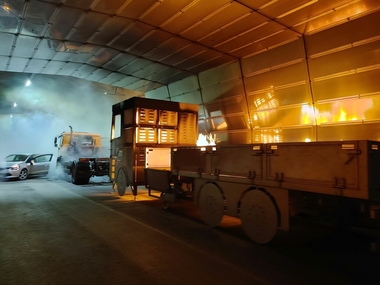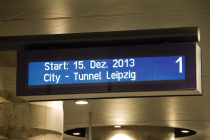Safely through the Tunnel? – How People behave in Tunnel Fires
The following report is a paper to be presented at the German tunnel-Forum, which is staged regularly by your tunnel magazine in conjunction with the STUVA. The next forum will be held in Stuttgart on November 6, 2012 and Munich on November 7, 2012.
Should fire break out in a road tunnel it is essential that users react quickly and properly. Early detection of the danger, speedy triggering of a fire alarm and rapid evacuation of the tunnel can save lives. Thus it remains a critical factor that many motorists do not react appropriately to risks within the tunnel and actually place themselves in even more danger in some case through false behaviour. The analysis of the fire disaster in the Tauern Tunnel on May 29, 1999 revealed that some motorists did not vacate their vehicles or returned to them in order to recover documents. In this particular case this behaviour cost 3 lives [1]. This is where psychological safety research has a role to play by determining exactly how tunnel users behave and then by developing measures, which can improve the reactions of motorists during critical situations (Fig. 1).
The field investigation described here accomplished by the University of Würzburg together with the Federal Highway Research Institute (BASt) and the University of Bochum [2] represents an example for this kind of applied psychological safety research. In the study the test persons taking part were confronted with an accident scenario involving fire in a road tunnel and their behaviour was observed. In addition to the systematic analysis of user behaviour, 2 measures for improving behaviour in the event of tunnel fires were to be evaluated and the validity of comparable studies examined in virtual reality.
45 test persons were randomly allocated to one of 3 investigation scenarios: a naïve control group received no information at all in advance relating to proper safety behaviour in the tunnel. A second group read an information brochure from the Federal Highway Research Institute (BASt) on safe conduct in road tunnels (a link with download of the brochure is to be found at the end of this article) – and a third group also read the brochure and practised proper behaviour during tunnel fires in a virtual driving simulator (Fig. 2). A week later all the candidates drove through the actual road tunnel, which corresponds to the latest safety regulations contained in the Guidelines for Furnishing and Operating Road Tunnels (RABT) [3]. During the journey the tunnel was blocked by a simulated traffic accident with accompanying fire (Fig. 1).
An accident involving fire in a tunnel requires fast and proper reactions. The appropriate behaviour was passed on in the form of the information brochure and the virtual training the previous week. It is regarded as being especially important that the vehicle is vacated as soon as possible, to fetch help (e.g. via an emergency telephone) and then to use an emergency exit to get to safety. The behaviour of the test persons, who were not aware in advance just what awaited them in the tunnel, was analysed in an initial step, based on observation protocols and video recordings with respect to the desired manner of behaviour.
The data clearly revealed that inappropriate and self-endangering behaviour first and foremost occurred in the non-informed, untrained group of candidates. Thus a good 1/5th of this control group remained sitting in their vehicle, in some cases until it was completely enveloped with smoke. All in all less than the half of this control group tried to find the emergency exit or the emergency telephone in the vicinity of the scene of the accident. This is particularly surprising as the test persons usually came to a halt directly alongside the SOS-telephone or the emergency exit. This pattern of behaviour would be life-threatening in an emergency. Furthermore a series of inappropriate approaches were revealed: some of the candidates moved too close to the fire, simply remained seated in their vehicle or attempted to turn, something that represents a considerable risk in a 2-way tunnel. A subsequent survey indicated that some of the participants evaluated white smoke during a fire as less dangerous. Especially unexpected and thus extremely indicative was the erroneous behaviour of one female candidate, who tried to use an illuminated escapeway sign attached to the wall as a touchpad – although entirely impossible – to send an emergency call (Fig. 3).
The measures undertaken a week prior to the field study had a clearly identifiable positive effect on the safety behaviour. Almost 3/4s of the test persons, who had been briefed and all those trained in how to react tackled the situation adequately and vacated their vehicle at the accident scene either heading for the emergency exit or the SOS-telephone.
Another interesting result obtained from the investigation was that men and women acted differently: all uninformed participants without training, who headed directly to the SOS-telephone or the emergency exit, were female. Male candidates on the other hand tended to remain sitting in their vehicle presumably as they felt they were safe there. In other words without a preventive measure the male participants behaved in a far more inappropriate manner than their female counterparts. The information brochure on its own sufficed to reduce this difference between the sexes substantially and the virtual behavioural training saw the unfavourable behaviour of the male participants in the investigation disappear altogether. It can be concluded that informative measures and behavioural training in the virtual world in particular can considerably improve the safety behaviour of tunnel users, especially the men.
Apart from the type of behaviour the time that elapses till self-rescue also remains an essential variable. Every second that a tunnel user requires for evacuation purposes, can be decisive. The field study demonstrated that trained candidates vacated their vehicle more frequently as well as on average almost 20 seconds faster than participants belonging to the other groups involved in the study. In this case virtual behavioural training in particular appears to pay dividends as naive participants only provided with information required roughly the same time to vacate their vehicle. A possible explanation is that the behavioural training is registered in the so-called procedural memory. The sequence of actions stored there can be recalled with particular ease and speedily as pure factual knowledge. In other words the results confirm the assumption that behavioural exercises express a further fortunately mild example that modern safety installations are also unable to guarantee optimal behaviour on the part of users: in April 2010 the fire alarm was sounded in a motorway tunnel, in which there was a traffic tailback. The loudspeaker announcement called on the persons located within the tunnel to vacate their vehicle and the tunnel via the emergency exits. Eye-witnesses reported that only very few persons actually responded. Fortunately the alarm was sounded by error so that no one was hurt.
Human error has thus repeatedly led to in some cases serious consequences. Tunnel users frequently do not vacate their vehicle in the event of danger and do not seek out the nearest emergency exit in an orderly fashion to get to safety. The 2 above-mentioned examples as well as the analysis of further tunnel fires indicate 2 important points: firstly although safety conditions have improved substantially the extremely good general conditions are not always exploited optimally by motorists. Secondly apart from numerous functional behaviour patterns such as e.g. providing First Aid, initiating an emergency call or looking for an emergency exit there are typical, dysfunctional patterns such as remaining in the car during a fire, evacuating to non-fireproof rescue rooms or returning to the car. It is interesting to observe that only few persons react in panic to the described events. Rather it is observed that most people act in a considered manner even during extreme situations but frequently take false decisions [4].
However the optimal way to behave in the event of something happening is not always the same for different events: for instance 2 helpers lost their lives providing First Aid during the fire in the Viamala Tunnel (2006) whereas 2 lives were saved thanks to the unstinting efforts of others in the Vösendorf Tunnel (2008) [1]. A problem in optimising human behaviour should an incident occur in a tunnel is that many factors must be taken into consideration and that there are no generally valid rules, which apply to all hazardous situations.
The safety level in European road tunnels has been enhanced substantially by applying safety standards. Psychological safety research has in this connection always pursued the aim of further improving the safety of users thanks to empirical research. On the one hand the notion is to diminish the probability of accidents or other critical events occurring (primary prevention). Secondly the extent of damage (secondary prevention) has to be minimised for users should a dangerous incident take place. Examples for primary prevention are fatigue warning systems, which alert the driver to signs of drowsiness, which can occur increasingly in monotonous environments such are presented by tunnels. Training tunnel users can be classified as both primary and secondary prevention. Further important aspects of psychological safety research is the investigation of social influences in other words how people mutually influence one another in critical situations or the development of complex behavioural models to predict behaviour with the aim of optimising safety measures [5, 6, 7]. These goals could only be accomplished to a limited extent by field studies of the type described here.
Valid and multi-changeable investigation conditions, by means of which the factor of man can be purposefully scrutinised during road tunnel fires without persons being endangered, would be advisable here. The development of virtual worlds has made it possible to simulate such situations in an ecologically valid manner for some time now. This approach thus represents an excellent augmentation of extensive field studies.
Virtual worlds first of all enable tests to be executed repeatedly using standardised conditions; secondly situations can be simulated, which are hard to quantify in reality (too dangerous, too complex, uncontrollable situations). The Chair for Psychology I at the University of Würzburg makes use of a 3D multi-sensoric lab by means of which guinea pigs can be placed in a virtual room and their behaviour analysed realistically (Fig. 4) for psychological safety research within the scope of the SKRIBTPlus (protection of critical bridges and tunnels; a link to the project home page is provided as the end of this report). What is known as a cave system is used here. Towards this end visual simulations are projected on to 5 walls and in addition acoustic and olfactorial simulations presented. At the same time the behaviour as well as the physiological parameters and verbal remarks of the candidates can be assessed in a controlled manner.
In summing up it can be maintained that the consequences of human error in the event of tunnel fires can be fatal. Even the latest safety standards cannot provide any absolute safety especially should the users fail to act “rationally” as expected. The field study discussed here displays promising approaches for improving the behaviour of tunnel users. The possibilities of behavioural training in virtual reality must be emphasised in this respect. It must be said however that research in this field is just starting and further efforts will be needed so that the factor of man in tunnels can be more accurately described and comprehended.

